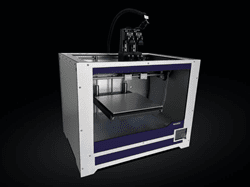
nano3Dprint’s B3300 3D electronics printer
nano3Dprint, a next-generation additive manufacturing solutions provider, today announced the launch of its B3300 Dual-Dispensing 3D Printer. The B3300 produces objects like medical devices, wearables, batteries, solar and other functional electronics with embedded circuitry.
More from the News
nano3Dprint, a next-generation additive manufacturing solutions provider, today announced the launch of its B3300 Dual-Dispensing 3D Printer. The B3300 produces objects like medical devices, wearables, batteries, solar and other functional electronics with embedded circuitry.
The printer’s unique, proprietary dual material dispensing system can print two different materials together to build combined material prints. The B3300 expands users’ range of printing materials – from gold and silver to UV curable polymers and silicone. Full 3D patterns may be printed onto any substrate and combine materials.
A wide viscosity range (1mPa·s to 54000 mPa·s) enables use of highly conductive inks in the B3300. Functional inks and pastes may be printed down to 8 mils (0.20mm) trace width. The printer is also able to quickly print thick layers (500 microns) with high viscosity multi-materials in a single pass, resulting in turnkey electronic items ready for use.
“The B3300 3D printer is a great solution for a wide range of applications. It can print wearables with embedded conductors, cell phone parts with internal antennas and electronic devices with internal sensors,” said Gretta Perlmutter, Product Success Manager, nano3Dprint. “It allows for incorporating sensors, strain gauges, heaters, complex antenna geometries and optical components in a 3D print and provides manufacturing solutions for the medical, agriculture and solar industries, and general consumer electronics.”
“This is a revolutionary development within the electronics 3D printing industry; new combinations of materials difficult to print together, like silicone and gold or dielectrics with semiconductors, can now easily be printed in combination with the B3300,” added Perlmutter.
The printer’s video inspection system allows users to monitor their progress in real time via computer to ensure an error-free high-resolution design print with accurate layer height, surface finishing, tolerance and roundness. The B3300 3D electronics printer is compatible with SD cards and flash drives for direct printing and is small enough to fit on a desktop. It is compatible with most CAD or Slicer software and retails for $6,000.
Subscribe to AM Chronicle Newsletter to stay connected: https://bit.ly/3fBZ1mP
Follow us on LinkedIn: https://bit.ly/3IjhrFq
Visit for more interesting content on additive manufacturing: https://amchronicle.com/
Bioprinting, the innovative application of 3D printing to biological materials, stands as one of the…
Additive Manufacturing (AM) has made significant strides in the last two decades, evolving from a…
Altair, a global leader in computational intelligence, announced its involvement in the Metallic Additive Manufacturing…
Innovation and reliability go hand in hand in 3D concrete printing. As a pioneer in…
In a move towards enhancing product longevity and promoting sustainability, electronics giant Philips has announced…
Netherlands-based CEAD is converting a 2,300-square-metre space near its head office in Delft into a…
This website uses cookies.